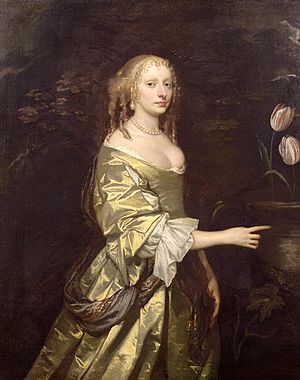Elizabeth Wilbraham facts for kids
Quick facts for kids
Elizabeth Mytton Wilbraham
|
|
|---|---|

Elizabeth Lady Wilbraham - by Sir Peter Lely
|
|
| Born | February 14, 1632 Weston under Lizard, Staffordshire, England
|
| Died | July 27, 1705 (aged 73) Weston under Lizard, Staffordshire, England
|
| Occupation | Architect |
| Spouse(s) | Sir Thomas Wilbraham, 2nd Baronet |
Elizabeth, Lady Wilbraham (born February 14, 1632 – died July 27, 1705) was an important member of the English upper class. Many people believe she was a very important supporter of architecture.
Some historians have even suggested that she was the first known woman architect. They think some of her work might have been credited to men. However, other experts on architecture do not agree with this idea.
Contents
Early Life and Travels
Elizabeth Mytton was born into a very rich family. When she was 19, she married Thomas Wilbraham. He was going to inherit a special title and land.
For their honeymoon, they traveled all over Europe. Elizabeth used this trip to study architecture for a long time. She learned a lot about building design during her travels.
In the Netherlands, Elizabeth Wilbraham met an architect named Pieter Post. He was known for creating the Dutch baroque style of buildings. She also studied the famous works of Palladio in Italy. She also visited the Stadtresidenz in Germany.
Her Personal Life
We don't know much about Lady Wilbraham's private life. But some of her personal letters were found in 2008. These letters showed how she tried to find good husbands for her daughters, Grace and Margaret.
A person from the Weston Park Foundation said that the letters show how important it was to marry well in her time. They also said that Lady Wilbraham was a very strong woman. She knew what she wanted and how to get it.
Was She the First Woman Architect?
Historian John Millar believes that Elizabeth Wilbraham was the first known woman architect. He says he spent over 50 years researching this topic.
In 2007, the owners of a large house called Wotton House held a meeting. They wanted to find out who designed the building. This meeting led to new ideas. John Millar suggested that Lady Wilbraham might have been the designer.
During the 1600s, women were not allowed to have professions like architecture. Millar thinks Lady Wilbraham used male architects to manage the building work for her. He believes she designed more than a dozen houses for her family.
Millar also thinks she designed 18 churches in London. These churches are officially credited to Christopher Wren. Wren started architecture later in his life. So, Millar has suggested that Elizabeth Wilbraham might have been his teacher.
Millar has even suggested that Lady Wilbraham might have designed as many as 400 buildings. He says these buildings look similar to Italian or Dutch architecture. Lady Wilbraham owned a copy of Palladio's famous book, I Quattro Libri. She wrote many notes in her copy of the book.
However, other experts disagree. In a well-known book about British architects, she is only mentioned once. She is listed as someone who supported architecture, not as an architect herself.
Millar himself admits that there are no letters or drawings signed by Lady Wilbraham. His ideas are based on her notes in Palladio's book. They are also based on how similar he thinks buildings look.
James Campbell, an expert on Christopher Wren, says Millar's claims are "mostly based on imagination and guessing." The curator of Weston Park, Gareth Williams, also said there is no proof she worked as an architect.
Important Buildings She May Have Designed
- Weston Park, Staffordshire (built around 1671) - Some sources, like Historic England, say Elizabeth Wilbraham designed it. But others, like the Weston Park Foundation, say William Taylor was the designer.
- St Andrew's Church, Weston-under-Lizard - This church is on the Weston Park estate. A famous architectural guide says Lady Wilbraham was involved in building it around 1700-1701.
- Wotton House, Buckinghamshire (rebuilt 1704–1714) - The architect for this house is unknown. Elizabeth Wilbraham or John Fitch have been suggested as possible designers.
See also
 In Spanish: Elizabeth Wilbraham para niños
In Spanish: Elizabeth Wilbraham para niños

